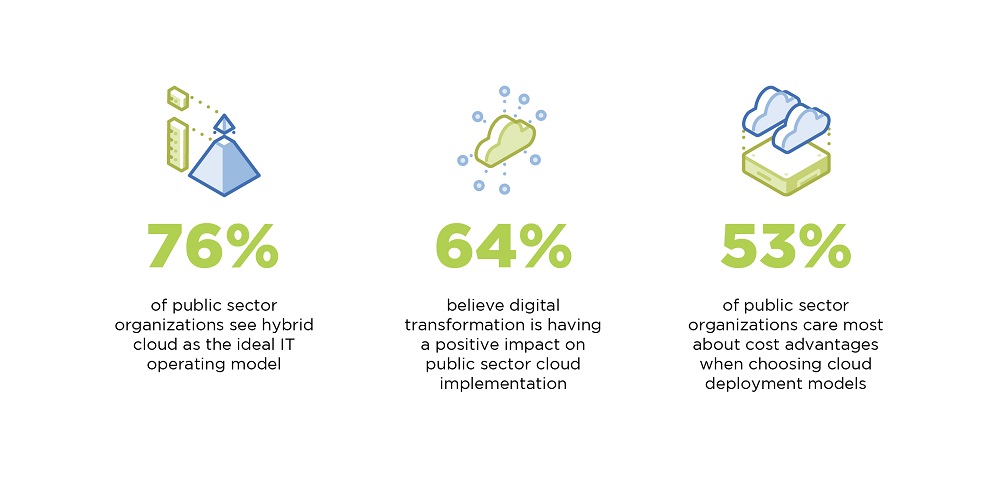The Key to Accelerating Innovation in the Public Sector
Historically, the public sector tends to adopt progressive IT practices at a slower rate than private sector organizations, hindering innovation. Year after year, agencies develop plans to dramatically reduce traditional datacenter use in favor of hybrid cloud and multicloud deployments, but these plans have yet to come to full fruition.
To learn more about the impact the cloud has on organizations globally, Nutanix commissioned a survey with Vanson Bourne to create the second annual Enterprise Cloud Index (ECI). From this, we looked at the data from public sector respondents and sought to answer the following question: What cloud deployment and planning trends are government organizations and public institutions prioritizing? The results follow.

Hybrid Cloud Usage is Top of Mind: Across all industries surveyed, the public sector ranks lowest for hybrid cloud adoption, but attitudes are shifting, as 76% of respondents said they see the hybrid cloud as the ideal IT operating model. The survey also revealed that the public sector plans to increase hybrid usage by 35%, taking a step to decrease traditional datacenter deployments and improve the innovation and IT infrastructure within their workforce.
Digital Transformation is Imminent: Digital transformation is having a positive impact on the public sector as they look to innovate IT models. The survey data showed that 64% of respondents cited digital transformation having positive impact on cloud implementation
within their organization, and 23% believed that digital transformation will have a positive impact on their day-to-day business operations.
Costs and Budget Remain Key Considerations: Cost control is crucial to ensure an organization can invest in the resources needed to drive digital transformation efforts. With 53% of respondents reporting that they care the most about cost advantages when choosing cloud deployments, repatriating unoptimized applications and data from the public cloud can help accomplish the necessary savings. With this in mind, nearly 49% of public sector organizations reported public cloud budget overages, with 16% being described as greatly over budget. With such significant budget overages, especially in a sector with notoriously slim budgets, the shift to hybrid cloud is necessary not just to improve agility and innovations but to better manage costs as well.
The data from the Public Sector ECI points to major changes coming, which are likely accelerated by the pandemic. As the public sector looks to modernize, cost management and hybrid cloud adoption will be the first steps on the journey to digital transformation. This effort will give public sector IT leaders better visibility into their cloud consumption across both public and private clouds, as well as better control of their entire cloud infrastructure.
To further understand digital transformation and discover how hybrid cloud can help, explore our eBook on Hybrid Cloud Solutions.
© 2020 Nutanix, Inc. All rights reserved. Nutanix, the Nutanix logo and the other Nutanix products and features mentioned on this post are registered trademarks or trademarks of Nutanix, Inc. in the United States and other countries. All other brand names mentioned on this post are for identification purposes only and may be the trademarks of their respective holder(s). This post may contain links to external websites that are not part of Nutanix.com. Nutanix does not control these sites and disclaims all responsibility for the content or accuracy of any external site. Our decision to link to an external site should not be considered an endorsement of any content on such a site. Certain information contained in this post may relate to or be based on studies, publications, surveys and other data obtained from third-party sources and our own internal estimates and research. While we believe these third-party studies, publications, surveys and other data are reliable as of the date hereof, they have not independently verified, and we make no representation as to the adequacy, fairness, accuracy, or completeness of any information obtained from third-party sources.
This post may contain express and implied forward-looking statements, which are not historical facts and are instead based on our current expectations, estimates and beliefs. The accuracy of such statements involves risks and uncertainties and depends upon future events, including those that may be beyond our control, and actual results may differ materially and adversely from those anticipated or implied by such statements. Any forward-looking statements included in this post speak only as of the date hereof and, except as required by law, we assume no obligation to update or otherwise revise any of such forward-looking statements to reflect subsequent events or circumstances.